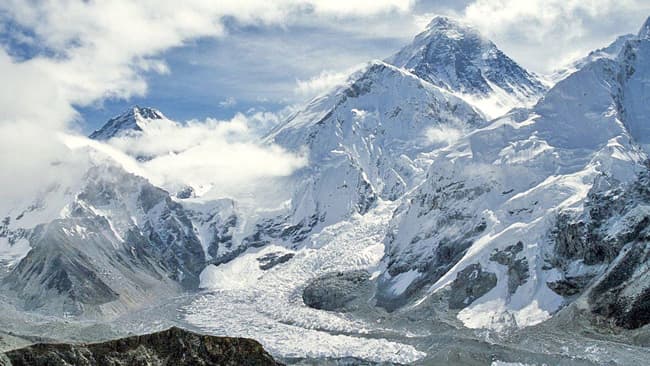Adverse effect of melting glaciers in J&K

Mohammad Hanief
The glaciers in the Kashmir Himalayas are melting rapidly, threatening water security in the region. This alarming rate of glacier melt in Kashmir and Ladakh has raised concerns among experts, who warn of significant impacts on regional water availability and hydrological systems. The melting glaciers in Jammu, Kashmir, and Ladakh will affect water, food, and energy security, with adverse consequences for the livelihoods that depend on them. The researchers explained that the main drivers of the glacial melt in the Himalayan region are increasing temperatures and decreasing snow precipitation, resulting from greenhouse gas emissions from industrialization and increasing use of fossil fuels worldwide.
The slow-moving glaciers of the Himalayas, essentially frozen rivers of ice, supply drinking water and support agricultural needs for vast populations across the Indo-Gangetic plains. Glaciers form over thousands of years as layers of snow accumulate, with the weight of the top layers compressing the lower ones into ice. This pressure, along with the pull of gravity, causes the glaciers to move.
As the carbon emission continues to increase, the melting of glaciers has gained a pace in Jammu & Kashmir while as the experts assert that the union territory has lost nearly 30 percent of glaciers in the past 60 years and warned that 70 percent of them will receive by the end of this century if the prevailing pace continues.

As per the available media reports in which experts informed that there are 18000 glaciers in Jammu, Kashmir and Ladakh, but all of them are melting. The glaciers are melting in the entire Himalayas including J&K. In the past couple of years, the melting of glaciers has increased. The record melting of glaciers was witnessed last year and this year it was a bit low.
Described as ‘nature’s bulldozers, these solid rivers melt gradually with rise in temperatures and pick up vegetation and silt that comes in their way while flowing creating snow bridges, gullies, glacial lakes, glacial troughs, icefalls, valleys, crevasses and moraines and cause major changes in the topography as they descend forming rivers rich in sediments.
Kolahoi glacier is Kashmir’s biggest glacier and is the main source of water for the river Jhelum, which serves as a blessing for the fertile Kashmir valley. It is named after the Kolahoi peak – ‘Goddess of Light’ and forms the West Lidder river upstream of Pahalgam and the East Lidder. Both the rivers join together to form the Jhelum river near Anantnag. Kolahoi’s meltwater renders the Kashmir Valley extremely fertile with cultivation of cereal crops, dry fruits, saffron, and apples.
Kolahoi Glacier has lost almost 23 percent of its area since 1962 and has fragmented into smaller parts. Recent study of experts on the Kolahoi Glacier, based on the last 10 years’ observation, showed that the average mass balance of the glacier has increased recently. The glacier is losing mass at the rate of about 1.0 m water equivalent annually, which is significantly higher than the glaciers in the rest of the Himalayas. The mass loss of the glaciers is expected to exacerbate in future as a result of the projected climate change, and thus further diminishing the stream flow of the trans-boundary rivers emanating from the region.
Glaciers in Kashmir, including the Thajiwas glacier in Sonmarg, Kousar-Nag glacier, snow reserves in Shopian, and the renowned Tarsar Marsar and Nun Kun Peak glaciers, are all experiencing accelerated melting due to the worldwide impact of global warming, as the consequences of this retreat are dire, as rising temperatures triggered by climate change and excessive pollution continue to take their toll.
The environmentally fragile region of Ladakh is also not spared from these adverse effects, as rising temperatures caused by climate change have put its glaciers at risk. The vulnerability of the Himalayan regions to Glacial Lake Outburst Floods (GLOF), increased chances of cloud bursts, sudden flash floods, and the looming threat of moronic material breach.
Climatic change-induced stream flow depletion is possibly one of the causes of land system changes in the Lidder watershed, the economic considerations perhaps play a much bigger role in forcing the massive unplanned land system changes in the watershed. However, the depleting stream flows in the Kashmir region can greatly affect water security in the region and have a major influence on agriculture, hydropower and domestic water use, given the changing climate prevalent over the region.
Experts observed that unprecedented increase in temperature, deforestation, increasing human activity, especially around Kolhai Glacier and high levels of pollution caused by the emission of greenhouse gases by vehicles and cement plants are major reasons for retreating of Kolhai Glacier. With decreasing precipitation trends including snow over Kashmir, warmer temperatures in winter led to less accumulation of snow and more recession of glaciers in the region.
Smaller glaciers are retreating more rapidly than larger ones due to their greater sensitivity to climate change, driven by their lower elevation and smaller accumulation areas. Glaciers located between 4200 and 4400 meters have receded more significantly than those found above 4800 meters. Additionally, glaciers with steep slopes experience less recession compared to those with gentler slopes, as the steeper slopes facilitate a faster transfer of glacier mass from the accumulation area.
Being an eco-fragile zone, Jammu and Kashmir is confronted with environmental challenges due to global warming, unplanned urbanisation, deforestation and encroachment of water bodies. Climate warming will not only affect the retreat patterns but might affect dependent sectors of the economy that include agriculture, hydropower, and tourism.
In Kashmir, the increasing pace of industrialization and the proliferation of concrete structures are exacerbating the environmental impact. Plastic pollution is another significant issue that is deteriorating water bodies, emphasizing the urgent need to address this menace seriously.
The Jammu and Kashmir government in its Draft Environment Policy, aimed at conserving the fragile environment, has recommended measures to protect and conserve critical ecological systems including climate change. The glaciers in Kashmir play a vital role as a major water source for irrigation through canals and water streams. Should these glaciers continue to melt at the current alarming rate, the region will face a deficit of irrigation for agricultural lands in the future.
This situation demands urgent attention and concerted efforts to mitigate the adverse effects of climate change on the region’s glaciers and the ecosystem they sustain. The time to act is now to ensure a sustainable future for Jammu and Kashmir.
